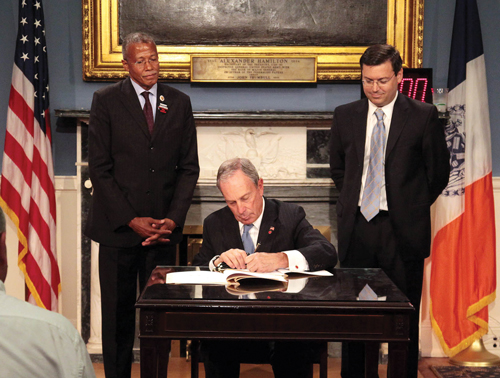 COMMISSIONER’S LETTER
COMMISSIONER’S LETTER COMMISSIONER’S LETTER
COMMISSIONER’S LETTER
By New York City Taxi and Limousine Commission Commissioner/Chairman David Yassky
|
So, the months of debate, negotiations and lobbying are done, and the votes are in. Mayor Bloomberg's Five Borough Taxi Plan is the reality we'd hoped for. On June 24 the State Senate echoed the earlier actions of the State Assembly and approved the plan and, with a stroke of Governor Cuomo's pen, the goal of bringing high quality taxi service to upper Manhattan and the boroughs outside of Manhattan will finally be achieved. And, since this is the Five and not the Four Borough Taxi Plan, pending the Governor's signature, we'll have the ability to make an additional 1,500 yellow taxi medallions available over three years to enhance service in Manhattan as well.
A moment of hard earned celebration for all those who worked on this is in order, but only for a moment because if the Governor does sign the bill into law, as we hope he will, the real work of crafting the administrative, operational and logistical details of the plan will quickly begin to unfold with the help of all the stakeholders over the next six months.
Of course, the victory for the riding public rings out as clear as a bell, but there are some very understandable concerns and priorities in mind for some out there reading these words. So, let's talk about them.
First, let's talk about enforcement. One of the all time sore points has been the fact that illegal liveries have been out there poaching business from both legitimate livery operators and yellow cabs for as long as anyone can remember. As hard as the TLC has come at them over these years the combination of TLC enforcement resource limitations and the sheer numbers by which this illegal activity takes place, thanks to public demand, has made it a challenge to control illegal poaching to say the least. We've won some battles, but the war rages on.
What I can tell you all today is that as part of the Five Borough Taxi Plan, and our agreement with the NY Taxi Workers Alliance, we will be going to the City's Office of Management and Budget for whatever resources are necessary to create a new force of at least 60 officers fully dedicated to combatting illegal street hail activity, protecting public safety, and supporting the legitimate livery and taxicab operators throughout the City.
I'm also pleased to announce that, beyond what I described above, we'll be celebrating the graduation of the TLC's latest class of Uniformed Officers just a week from the day that I write these words on July 22nd, and you can rest assured that they will be hitting the ground running thanks to the outstanding training they've received.
Another source of concern for some has been the value of the taxicab medallion. If you don't find compelling, as so many others do, the fact that 97½% of all taxicab business takes place in the Manhattan Central Business District or at the airport, and that only 2½% of taxi activity takes place everywhere else, then let me share these facts with you.

Mayor Bloomberg signs into law Intro. No. 473, which authorizes the modification of certain TLC license and inspection fees, some of which hadn't been updated since the 1980s, as Commissioner Yassky and Council Member Jackson look on.
Since the Mayor announced this plan in his State of the City address in January 2011 medallion values have continued to rise suggesting that the market doesn't believe that the plan will have a negative impact on medallion values. For example, corporate medallion prices over this period rose 18.2% (from a high sales price of $825,000 in January 2011 to $975,000 in June 2011), and individual medallion prices over this period rose 5.4% (from a high sales price of $650,000 in January 2011 to $685,000 in June 2011).
Of course, this is not the first time we've heard dire predictions that the issuance of additional medallions would negatively impact the medallion asset value. In fact, the Environmental Impact Study prepared in connection with the 2004-2007 auction of 900 medallions (representing an increase of 7.5% in the number of medallions) that we ourselves commissioned predicted that medallion values would decline by approximately 3% over that period. In actuality, corporate medallion prices climbed 66% over this period with individual medallions rising 40%. There is much more empirical evidence I could share with you to show that such negative projections are unlikely, but I think you get the point.
Perhaps, most importantly, you should understand that we're not creating more livery vehicles; rather, we're simply licensing the ones that currently exist many of which have been providing service in an illegal "underground market" environment. Even so, it's clear that the livery market functions as a separate market in separate geographies which does not have any effect whatsoever on medallion revenue or medallion values. Case in point, although the number of livery cars has increased 7.5% between 2008 and 2010 over that same period average medallion revenue increased 25%, average independent medallion prices increased by 29%, and corporate medallion prices have increased by 24%.
Nor is it the case that medallion values are wholly determined by medallion revenue. For example, while average revenue increased 8% between May 2010 and May 2011, corporate medallion prices increased by 21% and individual medallion prices increased by 11.5%. So, even if medallion revenue were impacted by this plan (and it's the drivers who would feel that impact, not the owners), it doesn't necessarily follow that medallion values would decline as there are other factors in play in determining medallion value (e.g., scarcity, speculation). Point of information, the latest average medallion prices are $673,000 and $950,000 for individual and corporate medallions, respectively, an increase of 1.2% and 2.6% in a single month.
The bottom line to all of this is that, as many livery operators and taxi drivers, and the major organizations that represent them have realized, there is good reason to celebrate and welcome the Five Borough Taxi Plan. Not only will it provide Northern Manhattan, Brooklyn, Queens, the Bronx and Staten Island with a new service they clearly want and deserve, but it contains the necessary elements to legitimize the hardworking livery drivers who have been providing this service on the fringe while enhancing the protection of legitimate livery and taxi drivers from any remaining unlawful challenges. I really hate the old "win-win" cliché ", but if you've got a better way of saying that this is a victory for everybody concerned, I'm all ears!